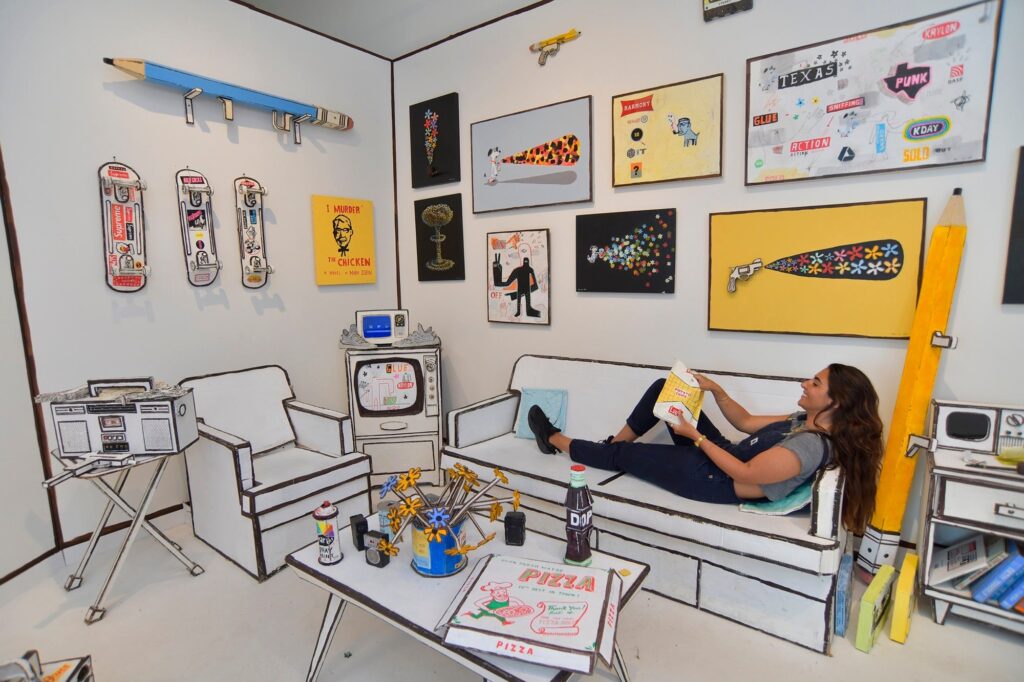Bill Barminski, a multimedia artist based in the United States, has carved a unique niche in the art world with his unconventional use of cardboard and mixed media to create thought-provoking sculptures and installations. His work often challenges societal norms, exploring themes such as consumerism, advertising, and the absurdities of modern life. Although not exclusively a street artist, Barminski’s aesthetic and thematic focus align closely with the ethos of urban art, making his inclusion in exhibitions like Beyond the Streets a natural fit.
In 2019, Beyond the Streets, a celebrated touring urban art exhibition, showcased a diverse roster of artists who have defined and redefined the boundaries of street and urban art. Barminski’s participation in this exhibit highlighted his ability to bring a fresh perspective to the urban art scene, bridging the gap between traditional street art and conceptual fine art.
Understanding Bill Barminski’s Artistry
Bill Barminski emerged in the 1990s, a period marked by rapid cultural and technological change. His early works were heavily influenced by pop culture, advertising, and the media’s pervasive presence in everyday life. While much of his early output included paintings and mixed media, he later shifted focus to 3D sculptures made from an unexpected medium: cardboard.
Barminski’s use of cardboard is both practical and symbolic:
•Practicality: Cardboard is cheap, accessible, and malleable, allowing Barminski to craft intricate replicas of everyday objects with remarkable precision.
•Symbolism: The material represents transience and disposability, themes central to his critique of consumerism and mass production. By transforming this mundane material into intricate sculptures of familiar objects, Barminski challenges the viewer to reconsider the value we assign to material possessions.
Signature Style
Barminski’s creations often feature oversized, whimsical renditions of items like typewriters, cameras, and weapons. These pieces are presented with hand-drawn textures, giving them a cartoonish, almost surreal quality. This aesthetic not only adds a playful dimension to his work but also underscores the absurdity of modern consumer culture.
Beyond the Streets 2019: A Celebration of Urban Creativity
Beyond the Streets is a monumental exhibition that celebrates the history, evolution, and impact of street art and graffiti. Curated by Roger Gastman, the exhibit highlights the diverse ways urban art has shaped contemporary culture. Featuring works from over 150 artists, Beyond the Streets provides a platform for both pioneering figures like Shepard Fairey and contemporary innovators like Bill Barminski.
Themes of the Exhibit
The 2019 iteration of Beyond the Streets focused on several key themes:
Graffiti’s Evolution: From its illicit beginnings on subway cars and city walls to its recognition as a legitimate art form.
Social Commentary: How urban art serves as a medium for addressing political, social, and cultural issues.
Commercialization: The tension between street art’s countercultural roots and its growing presence in galleries and commercial spaces.
Barminski’s Role in the Exhibit
Although not a traditional graffiti artist, Barminski’s work fits seamlessly into the exhibit’s exploration of urban art’s broader scope. His sculptures and installations often critique the same societal structures that street art rebels against, making him a natural addition to the lineup. For Beyond the Streets, Barminski likely showcased his cardboard replicas of iconic objects, emphasizing the humor and irony of modern consumer culture.
Barminski’s Connection to Urban Art
While Barminski’s work is not confined to the streets, his art shares several characteristics with street art:
Accessibility: Like street art, Barminski’s use of cardboard democratizes art by employing an everyday material that is accessible to all.
Critique of Power Structures: Both Barminski’s art and street art challenge societal norms, addressing issues like capitalism, surveillance, and mass media manipulation.
Interactivity: Barminski often invites viewers to engage with his work, whether by interacting with his sculptures or reflecting on their meanings. This aligns with street art’s goal of fostering a direct connection between the artist and the public.
Bill Barminski and Chicago’s Urban Art Scene
Although Beyond the Streets 2019 was not hosted in Chicago, the city’s rich history of urban art resonates with the themes explored in Barminski’s work. Chicago is home to iconic public murals, vibrant graffiti, and a thriving community of artists who use the city as their canvas. Barminski’s emphasis on reimagining everyday objects and critiquing societal norms aligns with the spirit of Chicago’s street art culture.
Notable Parallels
•Consumerism: Chicago’s urban art often critiques consumer culture, a theme central to Barminski’s work.
•Community Engagement: Like Chicago’s public murals, Barminski’s art encourages dialogue and reflection among viewers.
Impression of Beyond the Streets on the Art World
The Beyond the Streets exhibition has played a pivotal role in elevating street art and graffiti to new heights of recognition. By including artists like Barminski, the exhibit broadens the definition of urban art, showcasing its diversity and depth.
Legacy of the Exhibit
•Challenging Perceptions: Beyond the Streets challenges the notion that street art is merely vandalism, presenting it as a legitimate and multifaceted art form.
•Encouraging Innovation: The inclusion of unconventional artists like Barminski inspires other creators to experiment with new materials and ideas.
•Bridging Worlds: The exhibit bridges the gap between the streets and the gallery, creating a space where different forms of artistic expression can coexist.
Barminski’s Unique Contribution
Bill Barminski’s participation in Beyond the Streets 2019 highlights his ability to push the boundaries of contemporary art. By reimagining everyday objects in cardboard and infusing his work with humor and critique, Barminski challenges viewers to reconsider their relationship with material possessions and societal norms.
His inclusion in this landmark exhibition underscores the growing recognition of urban art’s complexity and significance. As cities like Chicago continue to celebrate public art, Barminski’s work serves as a reminder of the power of creativity to provoke thought, inspire change, and redefine cultural narratives.
Whether in a gallery, on the streets, or in the minds of viewers, Barminski’s art leaves an indelible mark, inviting us to see the world—and ourselves—through a new lens.
No comments yet.








